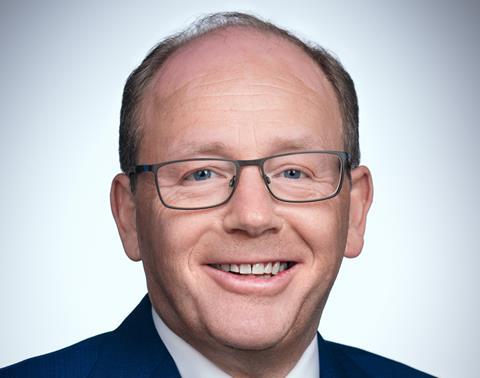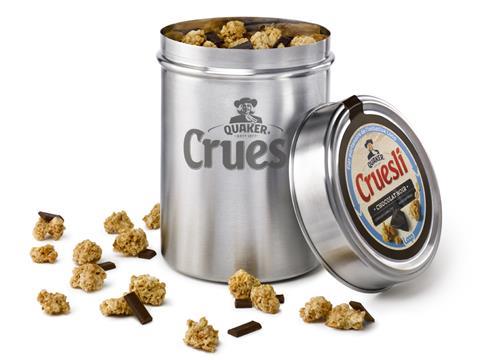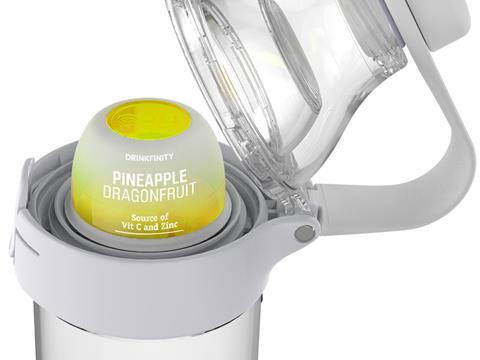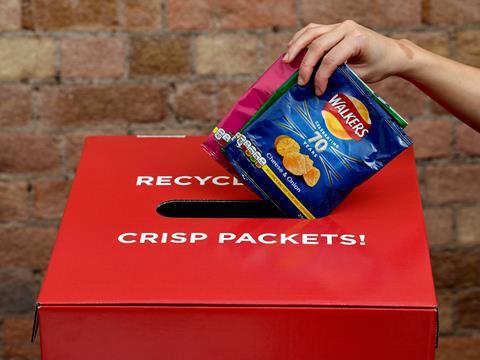
According to the Forbes Global 2000, PepsiCo was the world’s third largest brand owner in the food and beverage market in 2018, underlining the fact that there can be very few companies capable of exerting a comparable gravitational pull around sustainability. Ahead of his appearance as a keynote speaker at the forthcoming 8th Global Packaged Summit, PepsiCo’s VP for sustainability, Europe & Sub Saharan Africa Chris Daly spoke to Tim Sykes about the environmental challenges for packaged goods and the need to follow a multi-dimensional, long-term roadmap to meet them.
In his role, Chris Daly has to deal with the fundamental questions of sustainability, and connect these up to concrete packaging strategy across a diverse brand portfolio. Of course, there is no more central and agonising sustainability dilemma for packaging today than plastic pollution vs climate change. Shifting away from plastics offers immediate-term alleviation of waste in the natural environment, but at the expense of a negative impact on carbon emissions. Let’s plunge into the deep end: how do we get out of this double bind?
“As we ensure that plastic becomes circular and we make the transition to renewable energy, hopefully in time this will cease to be a dilemma we have to face,” said Chris Daly. “However, today it is a genuine consideration and we have to face up to concrete choices presented by the available portfolio of solutions. As I see it, climate change is a fundamental challenge which requires our immediate attention, so we can’t justify prolonging the increase in emissions. At the same time, it’s very important that we address the circular economy, and in particular look at the economics of the recycling value chain. Moving away from plastic in certain applications is understandable as a short term measure. However, if you look at the environmental implications of replacing plastic packaging with glass, for instance, you have to be cautious about unintended consequences. The longer term solution is to have a full circularity in plastics – and we need to get there as quickly as possible.”
As our readers are well aware, ‘circularity’ can be interpreted in manifold ways. PepsiCo has tended to take an inclusive approach to the wide portfolio of circular economy options. For instance, it is an active member of CEFLEX, and therefore a proponent of universal recycling, while also being a founding partner of the Loop reusable packaging concept.
"The exploratory element is what makes working in sustainability so exciting: the opportunity to step into new ideas that are imperfect at the outset, and follow them through to turn them into really good solutions."
“There are merits and disadvantages with each of the circular economy choices we face,” Chris remarked. “However, I think the problems will be eliminated over time, therefore we should be pursuing all of these areas in order to deliver longer-term solutions for a waste-free packaging system.
“Until recently, the industry hasn’t been doing an effective job at design for recycling. Thanks to greater focus on this, a lot of companies are starting to ensure that products are designed to be easily recycled in existing systems. My own company PepsiCo is among those that are stepping up.” As Chris sees it, recycling will become the mainstream option of the future – as long as the value chain can perfect the infrastructure around the recycling stream, to eliminate the inefficiency and wastage.
But alongside recycling, there is scope for a mixed ecosystem featuring other approaches. “Bioplastics could be a very interesting area, and flexible plastics is a clear area that could benefit,” Chris commented. “Given the difficulties inherent in recycling flexibles and the challenges around developing an economic stream for doing so, potentially there’s an opportunity to mix flexible bioplastics with food waste. We also need to bear in mind the need to move away from fossil fuel, so plant-based plastics are a significant area to consider – as long as we ensure we source them responsibly, with no impact on the food chain.”

Returnable packaging, as exemplified by the Loop initiative, is another approach offering distinct opportunities (consumer convenience, elimination of packaging waste) as well as associated challenges (controlling carbon footprint outside large urban areas). “There are reuse models that worked effectively in the past, and we now have a great opportunity to step back into them and make them work even better, thanks to the available technologies today,” said Chris. In joining Loop, PepsiCo has two key interests: monitoring consumers’ response to the model, while studying how it works and how it can be optimised to improve the LCA implications over time.
So for PepsiCo there’s no silver bullet, but rather a suite of promising, if imperfect, options that are there to be worked upon. “This exploratory element is what makes working in sustainability so exciting,” Chris revealed. “The opportunity to step into new ideas that are imperfect at the outset, and follow them through to turn them into really good solutions. Working from partial answers through to fully fledged solutions takes conviction and patience. In my experience, with any new option there’s some aspect that doesn’t look good, and you have to find a way to eliminate that disadvantage.”
Facing individual responsibilities, collaboratively
“As one of the world’s leading food and beverage companies, we recognise that we at PepsiCo have a role to play in changing the way society makes, uses and disposes of packaging,” said Chris. “We try to further sustainability by influencing others in the space.” In part, this responsibility drives internal efforts to fit better into the value chain and make the value chain itself more effective. It also means working pre-competitively with PepsiCo’s peers, NGOs and governments.
The overriding mission is to construct a packaging value chain that fulfils the circular packaging model, where there is no waste and no inefficiency. “My dream is to get to a place where we have an economically viable circular system in which everyone across the value chain can benefit from participation,” revealed Chris.
"There isn’t a better time to have these discussions"
Reaching that ideal place will mean creating a lot of transparency and fixing the bottlenecks along the way. “This relies on a whole range of stakeholders, and can’t be solved unilaterally by PepsiCo, or for example by the waste management companies,” Chris acknowledged. “Harmonisation of recyclability standards across different markets would be very helpful in creating a circular economy. Similarly, clear guidelines on food grade recyclable plastic would make a big difference. If you simplify the rules, it also clarifies the investment choices that brand owners have to make.”
Collaboration, then, is key to achieving common standards and development of viable technologies and infrastructures around them. PepsiCo plays an active role in many of the multi-stakeholder initiatives, including the New Plastics Economy and CEFLEX. It is also involved in the NaturALL Bottle Alliance, which has set out to develop recyclable, 100 per cent plant-based PET bottles from biomass – the first bottles are expected be introduced around the end of 2020.
“It’s refreshing to have these spaces where people come and share ideas in an unconstrained manner,” Chris reflected. “The competitive aspect of what we do stays outside the room. This kind of open mindset is crucial. An outstanding example of this is Starbucks and MacDonald’s, two big competitors, working together to come up with a next generation coffee cup. Similarly, P&G found a way of processing polypropylene bottles through the recycling system – and then shared that knowledge with their competitors so they could do likewise. Things like this epitomise the approach everyone needs to take.”
Three RE-s
In 2016 PepsiCo published a new set of sustainability goals to 2025. For packaging the headline implications are threefold: reducing plastics used; 100 per cent recyclability, biodegradability or compostability by 2025, and rethinking business models. These priorities guide the company’s internal R&D activities, as well as its strategy around external packaging innovation investments and partnerships.
With regard to plastic reduction, activities include ongoing lightweighting of bottles and reducing the thickness of the film used in multipacks. In the snacks business PepsiCo has introduced compaction technology, in other words getting the same volume of potato crisps into a reduced pack size.

Meanwhile, PepsiCo’s circularity commitments have set a goal of 45 per cent rPET content in its beverage bottles across the EU by 2025 and 50 per cent by 2030. According to Chris, they are on track to meet these pretty bold targets, which will have a knock-on effect on the overall rPET economy. In addition, the company has been driving recyclability across its portfolio through adaptations to its packaging, such as changing adhesives to facilitate recycling and moving from shrink sleeves to labels. To date, approximately 85 per cent of PepsiCo’s food and beverage packaging by weight is recyclable. “We’ve a clear line of sight to get to goal but there are some areas where there aren’t feasible recyclable alternatives today and this is the focus of PepsiCo’s fundamental R&D work targeted at delivering 100 per cent recyclability,” said Chris.
The third ‘Re-‘ is rethinking how PepsiCo does business. This has involved exploring different models for consumption that involve less packaging. It was this curiosity that drove participation in the pioneering Loop reusable packaging concept. It is also reflected in the acquisition of the home-carbonation brand SodaStream at the end of 2018, as well as the separate development of the Drinkfinity pod-based brand.
“We want to gather as much feedback as possible from consumers from these activities as part of the learning process as we rethink the market space,” observed Chris. “Bringing SodaStream into our portfolio is very much an opportunity to explore these ideas more deeply than we did previously.”
Key challenges
Scanning the PepsiCo portfolio, the beverage business looks more straightforward in terms of meeting sustainability objectives. Chris notes the shortage in supply of rPET but the task faced is mainly of an operational nature, and he expects to work through it relatively speedily.
Flexible packaging in the snacks business is a greater challenge. There is the familiar problem that the low value of PCR doesn’t cover costs, in turn creating a barrier to investment in new systems. In addition, R&D is complicated by the fact that easily recyclable materials must maintain the food safety and quality of products. In keeping with PepsiCo’s ‘mixed landscape’ approach, in addition to pursuing design for recycling, the company has been working on biopolymer flexibles, via a decade-long partnership with Danimer Scientific. Meanwhile, its Walker’s brand has recently piloted (with TerraCycle) a recycling scheme for crisp packets in the UK via 8500 collection points. In three months the scheme has collected half a million packets for recycling – albeit destined for lower grade applications, rather than new packaging.
Aside from market verticals, another key sustainability challenge is e-commerce. “The convenience advantages from a consumer standpoint are great,” Chris remarked. “However, e-commerce also generates lots of waste and that needs to be eliminated. There’s also a danger of higher greenhouse emissions. As part of my role, I have to look at that space and consider the product solutions we need to move to in order to build a more effective supply chain with less packaging waste. E-commerce is an idea that has taken off fast and other technology hasn’t quite caught up, but the speed of advancement today is fast.”

Certain concepts PepsiCo have invested in lend themselves to enhancing sustainable consumption via the direct-to-customer model. Subscription models combined with ‘beyond the bottle’ delivery – which potentially means shipping a lot less water – is one such model, and the whole market will watch the development of Drinkfinity closely. The big Loop experiment in reuse will also teach some important lessons.
Keynote
Chris will be presenting his vision live in two weeks - as a keynote speaker at the forthcoming Global Packaged Summit in Amstedam.
"The main focus of my presentation will be what circularity means for PepsiCo, where we are currently, and how we see the path going forward," he revealed. "There is so much focus on this area, so much collaborative change required. There isn’t a better time to have these discussions and I’m really looking forward to it."
Chris will appear at the 8th Global Packaged Summit, which takes place on 24-25 June in Amsterdam.
















